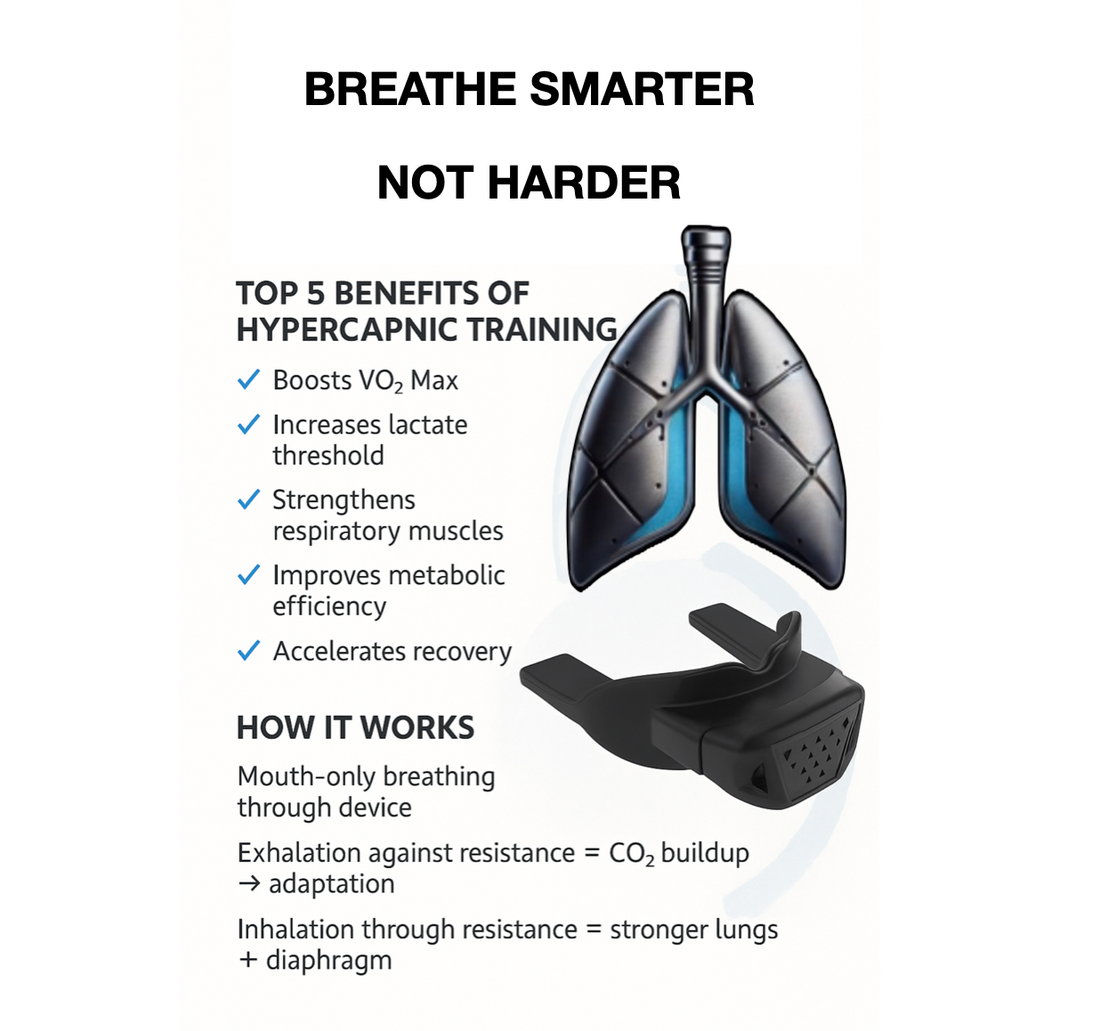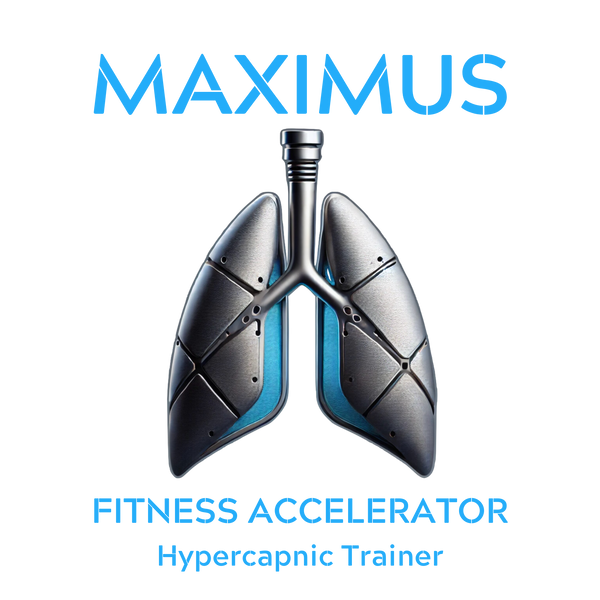
From Longevity to Increased VO2 Max & Increased Lactate Threshold, Why Hypercapnic Training Devices Are The Next BIG THING!
Share
The physiological reasons why hypercapnic training will become a preferred method and major trend for enhancing longevity, athletic performance, and overall health.
Enhanced Respiratory Muscle Strength and Endurance
Physiological Mechanism: Resistance during exhalation strengthens expiratory muscles (abdominal muscles, intercostals), enhancing pulmonary function.
® Greater respiratory muscle efficiency lowers respiratory fatigue during prolonged and intense activity.
Research Reference:McConnell AK. (2009).Respiratory muscle training as an ergogenic aid. J Exerc Sci Fit.
Increased VO₂ Max (Maximal Oxygen Uptake)
Physiological Mechanism: Hypercapnic conditions induce respiratory adaptations, increasing respiratory efficiency, enhancing oxygen delivery and utilization at the muscular level.
® Improved respiratory efficiency reduces the oxygen cost of breathing, allowing more oxygen to be available to muscles.
Correlation with Longevity: VO₂ max is a robust predictor of mortality and longevity. Increasing VO₂ max is directly associated with reduced all-cause mortality risk.
Research References:Cooper KH et al. (1989). Physical fitness and all-cause mortality. JAMA.
Lee DC et al. (2010).Long-term impact of cardiorespiratory fitness on mortality. Circulation.
Improved Lactate Threshold and Metabolic Efficiency
Physiological Mechanism: Higher CO₂ concentrations encourage better buffering capacity and lactate metabolism, increasing lactate threshold.
® Muscles adapt to utilize lactate more efficiently as fuel, enhancing metabolic flexibility.
Research Reference: Brooks GA. (2018). The Science and Translation of Lactate Shuttle Theory. Cell Metabolism.
Optimized Oxygen and CO₂ Exchange Efficiency
Physiological Mechanism: Training under hypercapnic conditions improves alveolar ventilation efficiency and pulmonary capillary perfusion.
® Enhanced gas exchange optimizes oxygen uptake and CO₂ removal efficiency over time.
Research Reference:Bernardi L et al. (2015). Respiratory muscle endurance training improves pulmonary function and gas exchange efficiency. Respir Physiol Neurobiol.
Enhanced Mitochondrial Efficiency and Density
Physiological Mechanism: Elevated CO₂ induces physiological stress signaling, stimulating mitochondrial biogenesis, enhancing mitochondrial density, and respiratory efficiency.
® Improved mitochondrial health directly contributes to longevity and reduced oxidative stress.
Research Reference:Holloszy JO. (2008).Regulation of mitochondrial biogenesis and longevity by exercise. Exp Gerontol.
Increased Hemoglobin Affinity and Oxygen Delivery (Bohr Effect)
Physiological Mechanism: Elevated CO₂ levels during training cause a rightward shift in the oxygen-hemoglobin dissociation curve (Bohr Effect), enhancing oxygen delivery at tissue levels.
Research Reference:Hall JE. (2020). Guyton and Hall Textbook of Medical Physiology.
Improved Cardiovascular Efficiency and Adaptation
® Physiological Mechanism: Hypercapnic training enhances cardiac output efficiency and stroke volume through increased peripheral resistance training effects.
® Enhanced vasodilation through elevated CO₂ levels improves peripheral circulation and cardiovascular adaptability.
Research Reference:Secher NH, Amann M. (2012). Human cardiovascular responses to hypoxia and hypercapnia. Exp Physiol.
Reduced Perceived Exertion (RPE) and Improved Psychological Resilience
Physiological Mechanism: Repeated exposure to elevated CO₂ during training reduces subjective discomfort, lowering perceived exertion during strenuous activities.
® Enhanced psychological tolerance improves stress resilience, contributing to consistent training adherence.
Research Reference:Marcora SM et al. (2009). Mental fatigue impairs physical performance. J Appl Physiol.
Improved Autonomic Nervous System Regulation
Physiological Mechanism: Hypercapnic breathing activates parasympathetic nervous system dominance, leading to improved heart rate variability (HRV), a key longevity biomarker.
® Improved vagal tone enhances recovery and longevity potential.
Research Reference:Lehrer PM et al. (2020). Heart rate variability biofeedback for cardiovascular health and longevity. Front Public Health.
Reduced Inflammation and Oxidative Stress
Physiological Mechanism: Controlled hypercapnia promotes anti-inflammatory signaling pathways, reducing systemic inflammation.
® Lower oxidative stress contributes significantly to reduced chronic disease risk and longevity.
Research Reference:Cummins EP et al. (2017). CO₂ levels regulate inflammation—Journal of Physiology.
Potential Cognitive and Neuroprotective Benefits
Physiological Mechanism: Mild elevation in CO₂ levels increases cerebral blood flow, potentially enhancing neurogenesis, cognitive function, and resilience against neurodegenerative processes.
Research Reference:Ainslie PN, Duffin J. (2009). Integration of cerebrovascular CO₂ reactivity and neural metabolism. Physiol Rev.
Enhanced Immune System Response
Physiological Mechanism: CO₂ modulates immune responses by regulating macrophage and leukocyte function, improving overall immune surveillance.
Research Reference:Sharabi K et al. (2009). Selective chemical regulation of inflammatory response by CO₂. FASEB J.
Why Hypercapnic Training Is the “Next Big Wave” in Training:
VO₂ max correlation with reduced mortality: Clear evidence supports enhanced VO₂ max as a predictor of longevity and reduced chronic disease.
Comprehensive metabolic and cardiovascular benefits:Multiple adaptive pathways positively influence overall physiological health.
Efficiency and time-effectiveness:Combines respiratory, metabolic, cardiovascular, and neurological adaptations in a single modality.
Accessibility and scalability:Devices like Maximus offer practical, scalable solutions for athletes, clinical populations, and longevity enthusiasts.
Emerging scientific evidence and mainstream adoption:A rapidly growing body of evidence and testimonials from professional athletes, trainers, and clinical researchers highlight efficacy and benefits.
Conclusion
Hypercapnic training uniquely combines profound respiratory, metabolic, cardiovascular, and neurophysiological adaptations that boost VO₂ max, enhance longevity biomarkers, and offer comprehensive health benefits. Given these extensive advantages, it is poised to become the preferred training method, significantly influencing athletic performance and longevity trends in the future.
Ideal Hypercapnic Training Device: Key Features
For hypercapnic training to be practical and widely adopted, an ideal device would have these attributes:
Dual Airflow Resistance (Inspiratory and Expiratory)
® Optimal hypercapnic training ideally involves expiratory airflow restriction to elevate CO₂ effectively.
® Adding inspiratory resistance enhances respiratory muscle strength and efficiency, boosting VO₂ max and exercise performance.
Lightweight and Portable
® Lightweight, compact, portable devices encourage daily use.
® Devices that are easy to carry, use, and integrate seamlessly into existing training routines have better user compliance.
Adjustable Resistance Levels
® Customizable resistance for various fitness levels—beginner, intermediate, advanced—is essential for progressive adaptation and sustained benefits.
Durable and Easy to Clean
® Devices used frequently must be durable, easy to sanitize, and require minimal maintenance.
Sleek and User-Friendly Design
® A sleek, intuitive design increases appeal, ease of use, and integration into regular training regimens.
Evaluation of the Maximus Fitness Accelerator (trainmaximus.com)
The Maximus Fitness Accelerator incorporates many ideal qualities for hypercapnic training:
Dual Airflow Resistance (Inspiratory and Expiratory)
Features patented DART (Dual Airflow Resistance Technology).
Restricts airflow on inhalation and exhalation, offering enhanced hypercapnic training (CO₂ elevation) and respiratory muscle strengthening.
Effective Hypercapnic Training
Specifically restricts exhalation, directly increasing CO₂ retention in the lungs, which is essential for triggering hypercapnic physiological adaptations:
® Enhanced respiratory muscle strength and endurance.
® Improved lactate buffering.
® Increased VO₂ max.
Compact and Lightweight
Sleek, portable, and small enough to integrate effortlessly into daily workouts and travel easily.
Encourages consistent and frequent usage, maximizing training adaptations.
Adjustable Resistance
Adjustable resistance allows users to scale training difficulty progressively.
Supports long-term usability for beginners and professional athletes.
User-Friendly and Modern Design
Aesthetically pleasing and intuitive design motivates regular use.
Compact and discreet enough for public use (e.g., gyms, fitness classes, team sports).
Is Maximus Fitness Accelerator Ideal for Hypercapnic Training?
|
Feature |
Maximus Fitness Accelerator |
Ideal for Hypercapnic Training? |
|
Dual (Inhale/Exhale) Resistance |
✅ Yes |
✅ Ideal |
|
Lightweight & Portable |
✅ Yes |
✅ Ideal |
|
Adjustable Resistance |
✅ Yes |
✅ Ideal |
|
Easy Maintenance & Durable |
✅ Yes |
✅ Ideal |
|
Sleek, User-Friendly Design |
✅ Yes |
✅ Ideal |
|
Evidence-Based Design |
✅ Yes (Patented DART) |
✅ Ideal |
Overall Evaluation:
The Maximus Fitness Accelerator (trainmaximus.com) is ideal for hypercapnic training. It aligns exceptionally well with established criteria, blending inspiratory and expiratory resistance in a user-friendly, portable, and practical training tool.
Why Maximus Stands Out
Patented Technology (DART):
® Specifically engineered to optimize hypercapnic adaptations.
Scientifically Grounded: Targets respiratory efficiency, lactate metabolism, mitochondrial adaptations, and improved VO₂ max.
Practical Integration: A lightweight and minimalist approach encourages routine use and consistency.
Conclusion and Recommendation
Given the physiological benefits, current research support, and device characteristics, the Maximus Fitness Accelerator from trainmaximus.com:
MAXIMUS is an ideal product for hypercapnic training.
® Combines respiratory resistance effectively to enhance physiological adaptations crucial for athletic performance, health, and longevity.
® Represents a strong candidate for becoming a mainstream training device due to its simplicity, portability, effectiveness, and well-supported physiological basis.
In summary, devices like the Maximus Fitness Accelerator perfectly encapsulate why hypercapnic training will soon become a mainstream, preferred method.
